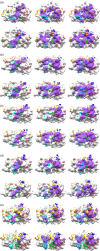A study of CDR3 loop dynamics reveals distinct mechanisms of peptide recognition by T-cell receptors exhibiting different levels of cross-reactivity
- PMID: 28992359
- PMCID: PMC5838422
- DOI: 10.1111/imm.12849
A study of CDR3 loop dynamics reveals distinct mechanisms of peptide recognition by T-cell receptors exhibiting different levels of cross-reactivity
Abstract
T-cell receptors (TCRs) can productively interact with many different peptides bound within the MHC binding groove. This property varies with the level of cross-reactivity of TCRs; some TCRs are particularly hyper cross-reactive while others exhibit greater specificity. To elucidate the mechanism behind these differences, we studied five TCRs in complex with the same class II MHC (1Ab )-peptide (3K), that are known to exhibit different levels of cross-reactivity. Although these complexes have similar binding affinities, the interface areas between the TCR and the peptide-MHC (pMHC) differ significantly. We investigated static and dynamic structural features of the TCR-pMHC complexes and of TCRs in a free state, as well as the relationship between binding affinity and interface area. It was found that the TCRs known to exhibit lower levels of cross-reactivity bound to pMHC using an induced-fitting mechanism, forming large and tight interfaces rich in specific hydrogen bonds. In contrast, TCRs known to exhibit high levels of cross-reactivity used a more rigid binding mechanism where non-specific π-interactions involving the bulky Trp residue in CDR3β dominated. As entropy loss upon binding in these highly degenerate and rigid TCRs is smaller than that in less degenerate TCRs, they can better tolerate changes in residues distal from the major contacts with MHC-bound peptide. Hence, our dynamics study revealed that differences in the peptide recognition mechanisms by TCRs appear to correlate with the levels of T-cell cross-reactivity.
Keywords: CH-π interactions; binding affinity-interface area relationship; cross-reactive T-cell receptor recognition; fragment molecular orbital method; molecular dynamics simulation.
© 2017 John Wiley & Sons Ltd.
Figures



Similar articles
-
Peptide-MHC Binding Reveals Conserved Allosteric Sites in MHC Class I- and Class II-Restricted T Cell Receptors (TCRs).J Mol Biol. 2020 Dec 4;432(24):166697. doi: 10.1016/j.jmb.2020.10.031. Epub 2020 Nov 4. J Mol Biol. 2020. PMID: 33157083 Free PMC article.
-
Conserved Vδ1 Binding Geometry in a Setting of Locus-Disparate pHLA Recognition by δ/αβ T Cell Receptors (TCRs): Insight into Recognition of HIV Peptides by TCRs.J Virol. 2017 Aug 10;91(17):e00725-17. doi: 10.1128/JVI.00725-17. Print 2017 Sep 1. J Virol. 2017. PMID: 28615212 Free PMC article.
-
Quantifying conformational changes in the TCR:pMHC-I binding interface.Front Immunol. 2024 Dec 2;15:1491656. doi: 10.3389/fimmu.2024.1491656. eCollection 2024. Front Immunol. 2024. PMID: 39687625 Free PMC article.
-
Structural basis for self-recognition by autoimmune T-cell receptors.Immunol Rev. 2012 Nov;250(1):32-48. doi: 10.1111/imr.12002. Immunol Rev. 2012. PMID: 23046121 Review.
-
Thermodynamics of T-cell receptor-peptide/MHC interactions: progress and opportunities.J Mol Recognit. 2008 Jul-Aug;21(4):275-87. doi: 10.1002/jmr.896. J Mol Recognit. 2008. PMID: 18496839 Free PMC article. Review.
Cited by
-
MHC binding affects the dynamics of different T-cell receptors in different ways.PLoS Comput Biol. 2019 Sep 9;15(9):e1007338. doi: 10.1371/journal.pcbi.1007338. eCollection 2019 Sep. PLoS Comput Biol. 2019. PMID: 31498801 Free PMC article.
-
Understanding TCR affinity, antigen specificity, and cross-reactivity to improve TCR gene-modified T cells for cancer immunotherapy.Cancer Immunol Immunother. 2019 Nov;68(11):1881-1889. doi: 10.1007/s00262-019-02401-0. Epub 2019 Oct 8. Cancer Immunol Immunother. 2019. PMID: 31595324 Free PMC article. Review.
-
Strategies and rules for tuning TCR-derived therapy.Expert Rev Mol Med. 2023 Dec 14;26:e4. doi: 10.1017/erm.2023.27. Expert Rev Mol Med. 2023. PMID: 38095091 Free PMC article. Review.
-
epiTCR-KDA: knowledge distillation model on dihedral angles for TCR-peptide prediction.Bioinform Adv. 2024 Nov 29;4(1):vbae190. doi: 10.1093/bioadv/vbae190. eCollection 2024. Bioinform Adv. 2024. PMID: 39678207 Free PMC article.
-
Enhanced T cell receptor specificity through framework engineering.Front Immunol. 2024 Mar 12;15:1345368. doi: 10.3389/fimmu.2024.1345368. eCollection 2024. Front Immunol. 2024. PMID: 38545094 Free PMC article.
References
-
- Yin Y, Mariuzza RA. The multiple mechanisms of T cell receptor cross‐reactivity. Immunity 2009; 31:849–51. - PubMed
-
- Mason D. A very high level of crossreactivity is an essential feature of the T‐cell receptor. Immunol Today 1998; 19:395–404. - PubMed
-
- Huseby ES, White J, Crawford F, Vass T, Becker D, Pinilla C et al How the T cell repertoire becomes peptide and MHC specific. Cell 2005; 122:247–60. - PubMed
Publication types
MeSH terms
Substances
LinkOut - more resources
Full Text Sources
Other Literature Sources
Research Materials
Miscellaneous

